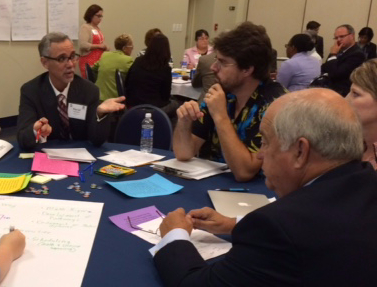|
| STEM leaders plan strategy, innovation |

Teachers need increased support in understanding and implementing STEM education, along with efforts to promote STEM fields to students and improve alignment among systems from kindergarten through college. That's the assessment of a group of STEM leaders and educators from across North Carolina who recently gathered at NC A&T State University to discuss science, technology, engineering and mathematics (STEM) education with NC New Schools/Breakthrough Learning.
"We recognize the great importance and challenges of stimulating bright students' interest in a love of math and science," N.C. A&T State University Chancellor Harold Martin said, referencing his university's partnership with Guilford County Schools' STEM early college. "Every time I get a chance to go into the school and engage with these high school students, they are smart, passionate and confident. Their love and application of math and science will one day help solve some of society's most complex problems."
Representatives from six universities, five school districts, the Department of Public Instruction and key business partners worked together at the meeting to begin developing a unified approach to STEM education. Educators at the event discussed best practices and shared challenges they face.
"We need autonomy to be creative in schools," said Sharrell Howard, teacher at Charlotte Engineering Early College. "When you move from drill and kill to collaborative classrooms, your test scores sometimes initially take a dip. That's not always accepted at the district level. We need more empowerment to take risks."
|
|
Survey: Skills gap leaves jobs unfilled
|

A quarterly report from Duke University's Fuqua School of Business says "nearly half" of chief financial officers at U.S. firms complain that jobs are going unfilled because of a skills gap. The Duke-CFO Global Business Outlook survey, released this month, reports that 93 percent of companies participating in the survey say they have job openings and can't find qualified workers.
Openings exist in high-tech industries, but Duke researchers say companies also report needing more mechanics, welders and other trade workers. U.S. employers predict employment and wage growth will be strongest in services/consulting, health care, tech, retail/wholesale and construction.
|
|
Rural education serves as economic driver
|
The Corporate Social Responsibility Newswire (CSRwire) recently featured a post by Jason Kessler (shown, center, with students from Hertford County Schools), director of community development for NC New Schools/Breakthrough Learning, as part of its series on Education for a Sustainable Future. The following is an excerpt from his blog post.
 State and local government response to rural economic development has revolved primarily around incentive packages to lure new industry to these areas. These incentives have helped bring some new business to rural regions. But rural America's unemployment rate remains twice that of the national average, triggering many community leaders in these depressed areas to rethink the approach for using incentives in the quest for business recruitment. State and local government response to rural economic development has revolved primarily around incentive packages to lure new industry to these areas. These incentives have helped bring some new business to rural regions. But rural America's unemployment rate remains twice that of the national average, triggering many community leaders in these depressed areas to rethink the approach for using incentives in the quest for business recruitment.
The urgency for economic development in rural towns cannot be addressed by incentive programs alone. Rural leaders must look to their local education system as an engine to drive economic growth and sustain a healthy community. The demand for workers with skills that can be transferred across industries is increasing. It is essential that government, business and community leaders in the state's rural areas collaborate to design school systems that focus on supplying graduates with the essential skills that will attract employers.
Rural communities can build a strong foundation for economic growth and industry recruitment by demonstrating a commitment to strategies that increase the number of skilled graduates in the labor force. Forging new partnerships between business and education that seek to expand access to high quality education and built-in support structures to address the challenges students in high needs communities face, will not only improve the career outlook for all students, but will also build a workforce of attractive candidates for employers to hire for years to come.
Read the complete blog post on CSRwire... |
|
New year means new strategies for learning
|
 Starting a new school year typically means new pencils, pens, notebooks and other materials. But it's also a great time for teachers to try out new strategies and protocols in the classroom. Starting a new school year typically means new pencils, pens, notebooks and other materials. But it's also a great time for teachers to try out new strategies and protocols in the classroom.
Instructional Coach Kristin Lampe has been working with Kathy Holland, a social studies teacher at Chase High School in Rutherford County. As a teacher designer, Mrs. Holland is working to renew her classroom activities so that lessons are designed to be learner-centered and to meet the outcomes that she has for her students. Her goal this year is to design lessons with one new strategy every week.
|
| Online tools provide new college rankings |
The U.S. Department of Education recently launched a redesigned online tool with college-specific information about student costs, loans and potential earning power. The College Scorecard provides a snapshot of what former students of each school might earn, how much debt they leave with and what percentage can repay their loans.
The scorecard offers the first comprehensive look at post-college earnings for students who attended all types of undergraduate institutions, based on tax records. The site allows prospective students to find the proportion of students at a school who earned more than they would have if they entered the job market right after high school. The site also reports the median earnings of former students who received federal financial aid, at 10 years after entering the school, with a comparison to the national average, as well as graduation rates, typical student debt and monthly payments a student would owe for each school.
In related news, The New York Times has released its College Access Index, which rates colleges and universities based on how much they do to help low-income students. The ranking placed the University of North Carolina at Chapel Hill in 16th. Six of the top seven spots went to University of California campuses. The index is based on three factors: the share of students receiving Pell grants (which typically go to families making less than $70,000); the graduation rate of those students; and the net cost, after financial aid, that a college charges low- and middle-income students. The index covers 179 of the nation's top colleges, defined as having an overall five-year graduation rate of at least 75 percent.
|
|
Baker tapped to lead rural schools initiative
|
 After successfully launching the National Academy Foundation partnership with NC New Schools/ Breakthrough Learning, Laurie Baker has been promoted to senior director of Rural Innovative Schools. She leads the newly expanded Rural Innovative Schools team that is working to address the unique challenges of high-need students in rural communities. After successfully launching the National Academy Foundation partnership with NC New Schools/ Breakthrough Learning, Laurie Baker has been promoted to senior director of Rural Innovative Schools. She leads the newly expanded Rural Innovative Schools team that is working to address the unique challenges of high-need students in rural communities.
Baker is charged with leading the effort to expand evidence-based college and career readiness strategies at the national level. In addition, she will focus on adapting workforce development strategies that are typically reserved for students in urban communities.
Read more about Bakers's career in teaching and leading... |
- Find information online about the 2016 session of NC Governor's School. This summer residential program for intellectually gifted high school students integrates academic disciplines, the arts and unique courses. The program, which is open to rising seniors only, is located on two campuses: Governor's School West at Salem College in Winston-Salem and Governor's School East at Meredith College in Raleigh. Click here for more information and nomination packets.
- The Burroughs Wellcome Fund has called for proposals for the BWF Promoting Innovation in Science and Mathematics (PRISM) Grant Award. The award supports teaching professionals in their efforts to provide quality hands-on, inquiry-based activities for their students. This award provides up to $3,000 for one year to cover the cost of equipment, materials, and supplies. An additional $1,500 may be requested for professional development related to the implementation of new equipment or use of materials in the classroom. Awards are made to teaching professionals that hold a professional educator's license to teach in a North Carolina K-12 public school. The Request for Proposal application can be found here. Click here for details about submitting an application.
- The Friday Institute MOOCs for Educators continue with four courses offered this semester. All courses begin today, Sept. 28, 2015. Click on the following course titles for more information: Learning Differences, Digital Learning Transitions: Creating Future Ready Schools, Coaching Digital Learning: Cultivating a Culture of Change and Teaching Statistics Through Data Investigations.
|
|
|
Thanks for subscribing to INNOVATOR, an update on school and district transformation from NC New Schools/Breakthrough Learning. Our newsletter aims to inform practitioners, policy makers and friends of public education on innovation, workforce development, research and success stories from schools, districts and regions across the nation. Please contact us to provide feedback and suggest ideas.
|
|
|
 |
 |
|
|